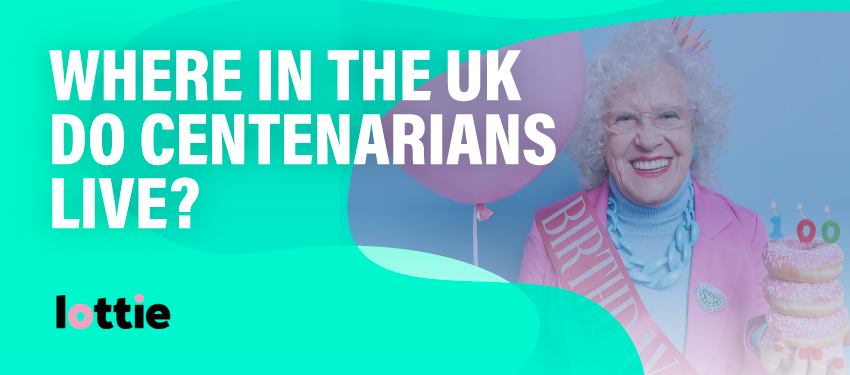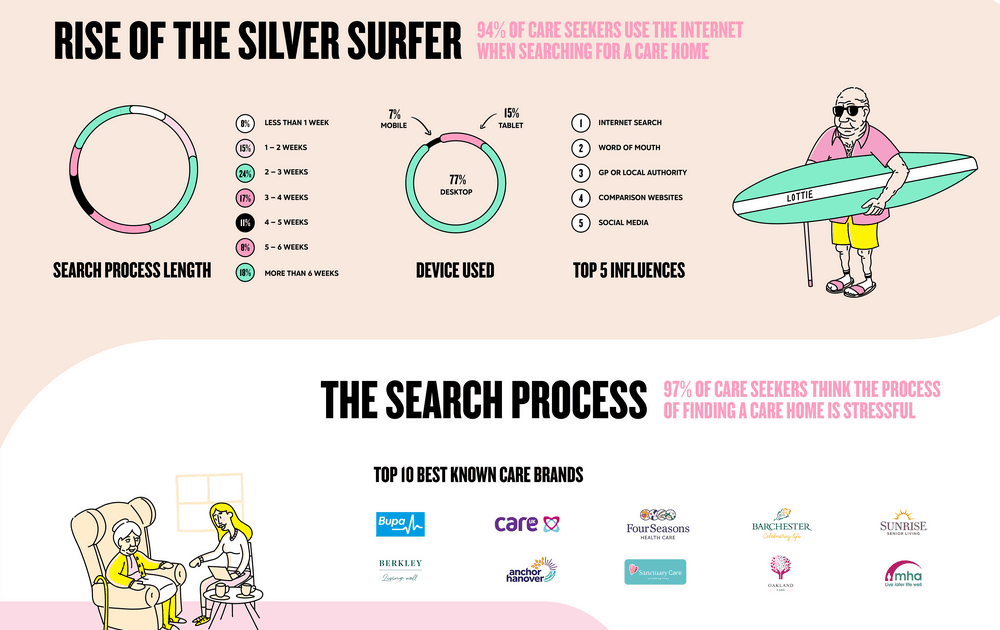100 Years Young: UK Centenarians Statistics Study

Estimated Reading Time: 12 minutes
Getting old is something that will affect most of us. However, it is likely that only a few of us will live to see our 100th birthday. In fact, only a few of the world’s oldest celebrities are aged 100 or over. But are you more likely to become a UK centenarian (100 years old) in some parts of the country compared to others? Are areas with the most older people also the best places for elderly people to live?
With this in mind, data was gathered for the oldest people in the UK and where they live(d). From this, the total number, and average age, of UK centenarians per region was calculated.
We've also shown how trends have changed over time, along with the number of centenarians and supercentenarians in the UK as a whole, the likelihood of reaching 100, how many people turn 100 in the UK each day and more.
Where would you like to live?
Browse the best retirement homes near you through Lottie.
In this article:
- What is a centenarian?
- How many people are there over 100 in the UK?
- Supercentenarians in the UK
- Supercentenarian gender split in the UK
- Longest married couples in the UK
- The oldest living people in the UK
- Likelihood of reaching 100+
- How many people turn 100 in the UK every day?
- How does the number of centenarians in the UK compare to other countries?
- UK life expectancy
What is a centenarian?
A centenarian is somebody who has reached 100 years of age. With life expectancies across the world well below 100, being classed as a centenarian is considered an impressive feat.
There are currently an estimated 633,000 centenarians worldwide.
How many people are there over 100 in the UK?
In 2020, there were 15,384 people recorded as being aged 100 or over in the UK - this is a record high, and an increase of nearly 20% from the previous year. Across the past two decades, there’s been a 58% increase in the number of UK centenarians.
What percentage of the UK population lives to 100?
In 2020, 0.02% of the current UK population was aged 100 or higher. ONS data shows over 12,000 people aged 100 or more were female, while just 2,700 were male.
Latest estimates show that around one in three of today’s babies will live to 100. Your current age and gender play a big part in this.
Age breakdown (106+)
| Age | Number of People in the UK |
|---|---|
| 106 | 149 |
| 107 | 75 |
| 108 | 29 |
| 109 | 13 |
| 110 | 9 |
| 111+ | 6 |
Source: Oldest in Britain - 23/12/2020
Supercentenarians in the UK

Across the UK, there are 237 people aged 110 or above (supercentenarian). Noticeably, the lion’s share are found in England (206), followed by Scotland (18), Wales (11) and Northern Ireland (2). The vast majority of supercentenarians in the UK can be found in the southeast.
London leads the way and is home to 25 golden oldies, with an average age of 110.8. This is followed by Surrey in second, with 16 supercentenarians and an average age of 110.6. Completing the top three is Kent with 10 people aged 110 and above, and an average age of 111.2.
In fact, you have to go all the way down to Aberdeenshire, ranked 30th for the number of supercentenarians, to find the UK’s first non-English representative, and Scotland’s highest entry, in joint 27th position. However, Highland and Stirlingshire each have a resident who has lived to the ripe old age of 113 - making them joint first in the UK, with West Glamorgan, in terms of average age.
Down in 31st place, West Glamorgan happens to be Wales’ highest placed county for UK supercentenarians. Despite only ever having two supercentenarians in their population, this region of south Wales actually holds the title of the UK’s oldest county (with an average age of 113 for these two residents). No surprise, however, that Swansea happens also to be one of the best cities for elderly care in the UK.
By comparison, Staffordshire is England’s oldest county (in fourth place), with an average age of 112 for their two golden oldies. North East Lincolnshire follows closely behind in fifth with the same average age, but only one supercentenarian to its name.
Towards the bottom of the list, we have two counties from Northern Ireland. County Antrim (home to the country’s capital, Belfast) and County Down each have one person aged exactly 110.
We can help you find the perfect UK retirement home. Use our free service to filter by location, price, the facilities available, purchase type and more!
Supercentenarian gender split in the UK
In line with global trends of gender life expectancy, UK females are storming ahead of their male counterparts.
Of the 238 people in the UK aged 110 or above, an impressive 223 are female, representing 93.7% of the UK centenarian population. By contrast, 15 UK males have lived to a similar age, constituting a meagre 6.3%.
Longest married couples in the UK

The award for the UK’s longest married couple goes to W.& E. Jones. Having both been born at the turn of the twentieth century, they were married for a remarkable 83 years and 359 days - 80% of their lives.
Narrowly behind them are M.& H. Kaye, by a mere 29 days. Having both lived to the grand age of 106, they were married for almost 79% of their life and lived out their remaining days together on the south coast of England.
The next three longest married couples all share the same length of marriage (82 years), yet are separated by seven days between them.
E.A. Day (the second oldest male in our longest-married list) was married to E.M. Day for exactly 82 years and seven days until his death in 2019, when he was 107 years old. Having married just before the Second World War, this represented almost 77% of his life and over 81% of her life.
In fourth position overall, S.A. Burgess holds the crown for the longest marriage as a percentage of their life. Having been married to J.A. Burgess for 82 years and two days, she just made it to her 100th birthday in 1965, meaning she was married for 82% of her life. They are also, incidentally, the only recipients in the top 20 who were married prior to 1900.
In terms of life expectancy, over half of the couples buck the trend for women outliving men. In 13 of the 20 couples, the males lived longer, with three of the couples living to the same age.
The oldest living people in the UK - 2024 list
| Name | Age | Date of Birth |
|---|---|---|
| Ethel May Caterham | 113 | 21st August 1909 |
| Ada Thompson | 112 | 28th November 1910 |
| Edna Strickland | 111 | 6th March 1911 |
| Mary Florence Walker | 111 | 28th August 1911 |
| Mary Letitia Keir | 110 | 3rd March 1912 |
| John Alfred Tinniswood | 110 | 26th August 1912 |
| Mary Rosa Pevovar | 110 | 27th September 1912 |
| Merah Louise Smith | 110 | 9th November 1912 |
| Sylvia Annie Cissie Corfield | 110 | 21st November 1912 |
| Adela Lauretta Harrison | 110 | 2nd January 1913 |
Source: Oldest in Britain
The oldest person in the UK
Ethel May Caterham, born on August 21st 1909, holds the distinction of being the oldest living person (and woman) in the UK. As of June 16th 2023, Ethel is aged an impressive 113 years and 299 days old. Ethel is also one of the oldest verified people living in Europe.
Ethel was born in Hampshire and has now lived in Surrey for more than 50 years.
The oldest man in the UK
The oldest living man in the UK is John Tinniswood. John was born on 26th August 1912 and at the time of writing (4th April 2023), is 110 years old. John is the only male in the UK’s 10 oldest people.
John is also the oldest known living person in the county of Merseyside. John was born in Liverpool and is an avid Liverpool FC fan.
Changes over time (% of people that live to 100+)
In 1950, just under 725,000 people in the UK were 30 years old. Less than 2.2% of these made it to their 100th birthday. Just over half of these were women, yet the likelihood of men living to 100 is 0.84%, compared to 3.5% for women.
The chance of living to 100 slowly increases over the decades for the entire population.
1980 is the first time the likelihood of males living to 100 goes above one per cent. There were 288,000 males in 1980 who were 60 years old, yet only 3,000 of these reached their hundredth birthday. By comparison, there were almost 30,000 more females in the UK at this time, yet their chance of living to 100 was over 4%.
As we enter the twenty-first century, the chance of people living to 100 increases significantly.
In 2000, there were almost 213,000 people aged 80 (octogenarians). Over 5% of those people (42,000) would live to see 100. In terms of gender split, this equates to 2.5% of the male octogenarian population (roughly 3000) and 6.67% of the female octogenarian population (almost 12,900).
By 2010, the population of UK nonagenarians (90+) diminished to just over 100,000. Despite this, the chance of these people making it to 100 increased to a whopping 15%. Females continue to dominate this age bracket, making up over two-thirds of the population for 90-year-olds. Remarkably, 17.5% of these women would make it to 100, compared to 9.5% of men.
How many people turn 100 every day in the UK?
The number of people turning 100 in 2020 was 7,590 according to ONS which is an average of 20 people every day.
How does the number of centenarians in the UK compare to other countries?
The definition of old age will vary depending on where you live in the world.
Worldwide, people are generally living longer, largely thanks to improvements in quality of life, sanitation, nutrition, and access to healthcare facilities. Generally speaking, countries with the best elderly care tend to have higher life expectancies, which is certainly true here.
With just under 68 million inhabitants, the UK is the world’s 21st largest country. However, it ranks an impressive 10th in the world for the number of centenarians, and is the fourth highest European country behind France, Germany and Italy.
But in some respects, this is futile; countries with a higher population should statistically have more elderly people - so what about when we look at the data as a percentage of the total population?
The UK comes out in nineteenth place (with 23 centenarians per 100,000 people). Globally, the top three spots are dominated by the Caribbean island nations of Guadeloupe, Barbados and Martinique, with 75, 71 and 63 centenarians per 100,000, respectively.
In terms of gender split, 81% of the UK’s centenarian population are female. However, there are 67 countries with a greater percentage of centenarian women, including 10 nations where the entire centenarian population is, in fact, female.
Aruba, in the Caribbean, has four centenarians per 100,000 compared to Kiribati in the Pacific, which has two per 100,000. The remaining seven nations are all African nations, ranging from those who have one centenarian in their entire population (Sao Tome and Principe, Western Sahara, Comoros, and Burkina Faso) to Eswatini, which has three.
UK life expectancy
According to ONS research, life expectancy in the UK for men has fallen for the first time in four decades, to 79 years, whereas female life expectancy has remained largely unchanged, at 83.
Since 1841, life expectancy for males and females has roughly doubled. From 1969 to 2019, life expectancy for women increased by around 8 years, whereas life expectancy increased by around 11 years for men.
Over the next 50 years, life expectancy is predicted to increase by approximately 5.5 years for females and 6.6 years for males.
Methodology
- Lottie utilised data from the United Nations’ Population Dynamics to find the population estimates of people who are aged 100 and over.
- The number of 100+ centenarians per 1,000,000 people were calculated from 2020 estimates to find the country with the highest proportion of centenarians.
- Lottie also measured the number of centenarians in each country from 2000-2020 - to determine where the percentage of them is rising or declining
- The figures for male vs female centarians were also analsyed to identify any changes or trends for a particular sex over time.
- These countries were then ranked in order from the highest % of centenarians per one million people to the lowest.
- The Oldest in Britain webpage was used to find more detailed UK information:
- The number of individuals aged 30 in 1950 that made it to 100 in 2020 - measured in 10 year increments, to illustrate how the likelihood of reaching 100 years old changes as you age.
- A list of all the recorded ‘super-centenarians’, or people who have reached 110 years old in the UK - including their location and an overall female/male split.
- Longest married couples: A list of the top 20 longest married centenarian couples,along with the % of their lives that they spent married.
*All data was collected on June 23rd, 2022, and correct as of this date.
We’re on a mission to support individuals and their loved ones throughout each stage of their later living journey. For more information, check out everything Lottie has to offer.



